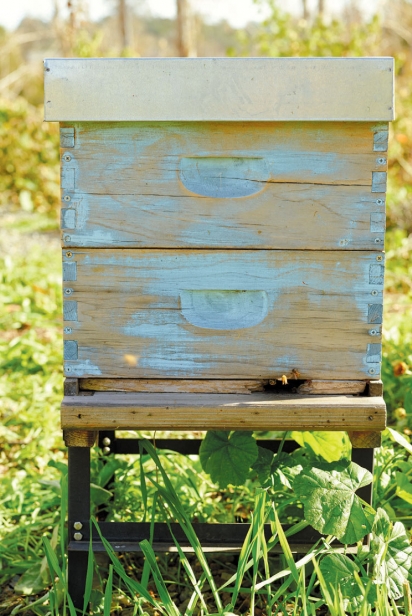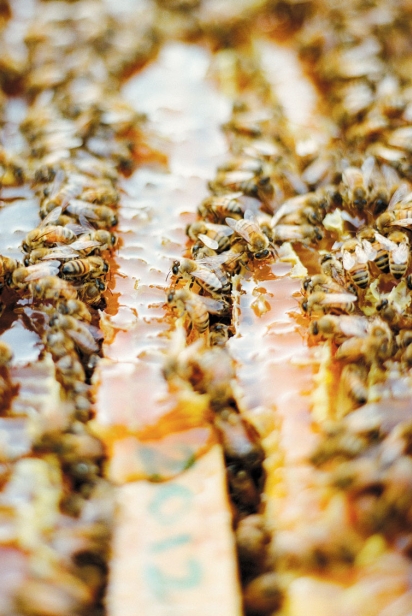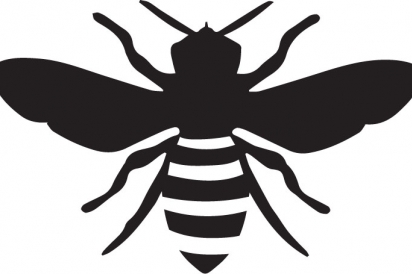A Buzz Between the Vines
Bees Don’t Do It
Although most vines are propagated from cuttings, grapes—like many other organisms—have sex.
Each seedling is thus a unique combination of genes from male and female plants. By far the majority of cultivated varieties, including those that produce wine grapes, are hermaphroditic (meaning they carry both male and female reproductive structures, and, accordingly, they fertilize themselves). Therefore, bees don’t fertilize grapevines.
So why do so many wineries either keep hives or employ professional beekeepers to do it for them?
“The health of our family’s property depends on it,” declares Chris Benziger, brand manager for Benziger Family Winery in Glen Ellen. He oversees the home ranch and many of its farm-related tasks, including shepherding the Benziger flock of sheep and cows, tending to estate vegetable and fruit trees and producing biodynamic preparations for the vineyards.
“Much of an area’s agricultural health depends on nitrogen balance. Some areas have too much and others too little. Where our concentrations are high we plant crops that deplete nitrogen, mostly grasses. Where there’s not enough we plant nitrogen fixers, often leguminous. Bees are the primary pollinators for both types of plants, all of which seem to aid in the natural replenishment of other important soil nutrients, as well.”
In other words, as bees gather pollen and nectar they pollinate these crops, which are then much more lush and viable and able to efficiently return nutrients to the soil.
But bees do much more than pollinate cover crops. They also help other insects feel safe.
“Bees are also pollinators for insectaries,” explains Justin Leigon, viticulturist at Napa-based Piña Vineyard Management. An insectary is a grouping of plants that are often planted around vineyard blocks or down the tractor rows. “They help these flowers succeed, which in turn draws beneficial predators such as lady beetles, green lacewings, soldier beetles and Anagyrus (a parasitic wasp for the vine mealybug). These are all general predators of vineyard pests, and their presence means that we have to intervene less because nature is doing it for us. Lots of bees are thus a good sign that you have a healthy vineyard with a diverse ecosystem.”
While much of the history of growing grapevines involved growers diminishing biodiversity in the vineyard in the belief that competition lowered yields and quality of the grapes, over the past several decades most experts and viticulturalists have reversed course on this crucial topic. In fact, current best practices strive for more diversity in the field in order to produce healthier vines and, thus, higher-quality grapes.
This is especially true in organic and biodynamic agriculture. In an interview with wine writer Jamie Goode of Wine Anorak (Wine-Anorak.com/waldininterview.htm), Monty Waldin, a leading expert on organic wines and author of The Friends of the Earth Organic Wine Guide, said that greater biodiversity is more likely to result in a proper balance between beneficial pests, such as ladybirds, and non-beneficial ones like spiders, which ladybirds eat. Nonorganic growers will chemically spray red spiders to protect their crop. In the short term, damage in the vineyard from spiders decreases, but in the long term the spiders reappear, “because (a) they develop resistance to the chemicals, and (b) the natural predators of the spider (the ladybirds) are also killed by the chemical sprays. The natural balance of the vineyard is destroyed, and chemical residues are in the groundwater and in the wine.”
A BEE STORY
The lessons in biodiversity that have been gleaned from these sorts of sustainable practices have spread to more conventional forms of horticulture, as well. But regardless of a winery’s metaphysical bent, a good way to differentiate between various bee systems is to divide their hosts into those who own their own hives and those who use the services of a professional beekeeper. This choice also seems to be more philosophical than practical. In other words (and not counting the hives’ beneficial impact on vineyard health), does any given winery really want to be in the bee business?
While there are additional expenses involved in keeping bees, many hive owners report an emotional connection to their wards. Loren Trefethen of Trefethen Family Vineyards relates that, in his and his sister Haley’s minds (Haley is the actual “bee lady” at Trefethen), keeping bees is a practice that is directly in line with their viticultural vision.
“We’re working toward a more resilient ecosystem. At Trefethen we say that we’re in the business of changing dirt into joy, an idea that connects how we shape nature’s response to produce all of our agriculture, from wine to oranges to honey.”
Trefethen’s hives are currently undergoing a process of rehabilitation. “An outside swarm killed our queen and it takes at least a year to rebuild a colony. So we’re working on that. But organic, farm-raised honey is awesome and so we’ll keep at it until we’re back in business!” Chris Benziger understands why the Trefethens are so eager to get back to beekeeping.
“Eating your own honey is so cool! It’s a sweet, lovely food that never spoils and is, in fact, used as an antiseptic ointment in a lot of home remedies.”
But it’s more than any of this to Chris.
“I have kids, and keeping bees helps teach them to take off the ‘time blinders’ that afflict so many of us in our busy, nonagricultural society. Bees are generational, just like our farm and our families, but their generations change so much faster than ours. It’s a great lesson in patience and in how to live in harmony with nature.”
THE ROAD MORE TRAVELED
So the practice of beekeeping can be rewarding in ways that are not necessarily monetary. But bees are fragile creatures and maintaining hives can be difficult and the rewards, tangible and intangible, seem to come at a relatively high cost, both financially and timewise. Hence, an increasing number of wineries hire professionals to do it for them.
One such professional is Kevin Ward, a beekeeper from east of Napa who is the co-owner of Hill & Ward Apiaries. Ward rotates his hives around various Northern California orchards during pollination.
“We do keep hives here, but it’s more of a sharecropping system,” says Lisa Mattson, marketing and communications director at Jordan Vineyard & Winery. “During the winter, when Kevin’s bees need a rest from pollination, they come live at Jordan. He brings them here because of our clean air and natural, pesticide-free environment. Kevin then gives us honey from those hives that ‘vacationed’ at Jordan that year, and we use it in our Estate Tour & Tasting for the cheese bento box pairing at Vista Point.”
“We’re grateful to be able to use wine country locations to house our bees,” says Ward. “This allows them to be in areas with abundant sources of pollen. The cover crops in the vineyards provide high-quality, natural nutrition sources for our bees at a time when there is a dearth elsewhere and allow the hives to be in a more healthy condition than if we fed even the highest quality and most expensive pollen supplement, which we’d be forced to do if we couldn’t place our bees on vineyard land.”
“It’s great that we have Kevin’s bees on our property,” says Brent Young, ranch manager at Jordan. “We see them in the vineyards, getting nectar from our cover crop flowers while pollinating them. They’re also influential in our garden, helping to pollinate our fruit trees and other blossoms. It’s a mutually beneficial relationship. We give them a home and they give us honey.”
Ward notes that vineyard cover crops, which are mixed floral food sources, actually produce very little harvestable honey. “Most of what is made in this case and at this time of year is consumed by the bees themselves and this is entirely beneficial in the long run.” The honey that wineries receive as “payment” is most often the prized single-varietal honeys produced from offsite hives tended by Ward.
Bill Leigon, president of Jamieson Ranch Vineyards, leases ground to a tenant farmer, who owns and cares for the Jamieson hives. “It’s all part of helping the local ecosystem,” says Leigon, whose career spans wineries and brands as diverse as Hahn, J. Lohr and Rex Goliath. “We’re not certified organic, but we are sustainable, and bees are only one element of how we naturally control what happens on our land. We also use falcons to control starlings and other bird pressures at harvest and we plant special flowers that provide their own chemical defenses to reduce pest infiltrations.”
It is important to note that this visiting bee arrangement is extremely time limited—in fact, it is dictated by the seasons.
“I need to take my bees out of the vineyards by mid-February, which is when they start to pollinate almonds. Vineyard owners can then begin regular spring viticultural practices without my hives being in the way.”
ACCIDENTAL TOURISM
So bees are important to vineyard health and vice-versa. But, as shown in the example given earlier by Lisa Mattson of Jordan, bees can benefit winery profitability even more directly through the sale of honey and, additionally, ecotourism. As Jordan’s Brent Young intimated, they also pollinate edible gardens, which have become so important to the meals that now often accompany winery tours.
“When there are lots of bees buzzing around,” says Chris Benziger, “somehow this is always when our gardens are at their best. No bees equals no garden, so in that sense they’re almost as important as water. Overall pest pressure also goes down as the buzz goes up, not only in our vineyards but along our walking trails and at our outdoor tables.”
Bees thus help tell the story of the Benziger family’s life work, and when customers view his hives “there’s usually an ‘aha’ moment, when they connect what we’re saying to what they see us doing. Bees are actually pretty docile creatures. Once the fear goes away, there’s often a revelation in the customer’s mind as to the importance of how we do what we do.”
WHAT COULD POSSIBLY GO WRONG?
One problem for Ward’s apiary business is that there are not currently enough locations in wine country for him to house all of his bees. “So we keep hives in other places, too. But the bees housed in vineyards end up in far better health than those in other locations that do not have adequate floral resources. These superior locations also help to ensure that our hives are more resistant to Colony Collapse Disorder (CCD).” Ward reports that he can regularly lose approximately a third of his wards over the winter.
A lot has been written about CCD, a phenomenon in which worker bees from a European honey bee colony abruptly disappear. The causes are not yet completely known but it seems to be brought on by a series of small disruptions to the environment, essentially a synergistic train wreck. And when it happens it is disastrous, not only for the bees but also for their keepers.
Two years ago, the Benzigers bought two new queens. “Within a few months they had both disappeared,” says Chris Benziger, “which was frightening. We don’t know why this occurred. What does it say for the world we’re leaving to our kids?”
Unusual weather patterns also disturb bees, and sometimes it’s hard to know exactly why and how things go wrong. “We think that the recent drought really hurt our bees,” says Chris, “and we lost three colonies in the last year. We’re down to only one but it’s big and hopefully it will split soon. Either that or we’ll catch a spring swarm and start a new one.”
At the heart of the matter, bees are just one tool in a winery’s box of techniques, used mainly to control vineyard pests. But they also provide sustenance in the form of honey, beautify and pollinate cover crops and the edible gardens that feed winery personnel and tourists alike, and teach us about the connections between a fragile ecosystem and our busy lives. There’s definitely a buzz in the air in wine country and the humble honey bee deserves a lot of the credit.
[Editor’s note: For more on CCD, visit EdibleMarinandWineCountry.com and search the term “bees” to read previously published stories on this troubling issue.]
BEE TRIVIA
Chris Benziger relates that the term “beeline” originated with what happens when a queen bee leaves the hive to mate. “The rest of the workers swarm out with the queen and they all have a hard time finding their way back to safety. Once the scouts relocate the hive they communicate this information to the swarm, which then heads directly home.”







